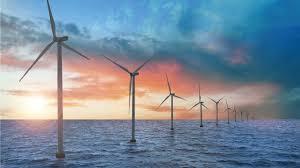Offshore Wind Energy Market Pain Points Hindering Global Clean Power Expansion
The offshore wind energy market is gaining momentum as a pivotal solution in the global transition to renewable energy. With its vast potential to deliver large-scale, zero-emission power, it is seen as a key player in achieving climate goals and reducing fossil fuel dependence. However, as the sector expands, several pain points are slowing its development, increasing project risks, and challenging the economic feasibility of large-scale deployment. This article outlines the primary challenges facing the offshore wind energy market and how they are impacting growth, investment, and technological advancement.

High Capital Costs and Long Payback Periods
One of the most persistent pain points in offshore wind energy is the high capital cost associated with project development. Offshore wind farms require significant upfront investment for site surveys, turbine installation, subsea cable laying, and grid connection infrastructure. The financial burden is further compounded by the need for specialized vessels, heavy-lift equipment, and remote operation centers.
These projects often have long payback periods, sometimes extending beyond a decade, which can deter private investment without strong government support or subsidies. Additionally, the financial risk increases in uncertain markets or developing countries with less regulatory stability and limited access to affordable project finance.
Complex and Lengthy Permitting Processes
Obtaining the necessary permits and approvals for offshore wind projects is often a time-consuming and bureaucratic process. Developers must secure environmental clearances, grid connection agreements, maritime permissions, and navigation safety approvals, each of which can take months or years.
This complex process varies significantly by region and is frequently subject to overlapping authorities or inconsistent regulation. The lack of standardized international permitting frameworks leads to delays, escalating development costs and creating uncertainty that can scare off potential investors.
Limited Grid Infrastructure and Integration Barriers
A major technical pain point is the lack of adequate grid infrastructure to support the transmission of electricity generated offshore to onshore grids. Many coastal regions, especially in emerging markets, lack the capacity or technology to handle large volumes of offshore wind energy.
Grid congestion, outdated systems, and the absence of long-distance interconnectors result in curtailment, where excess energy cannot be utilized. Additionally, intermittent power supply due to changing wind conditions poses challenges for grid operators trying to balance energy loads in real time.
Supply Chain Constraints and Equipment Shortages
As the offshore wind industry grows, supply chain bottlenecks are becoming increasingly pronounced. The market is experiencing shortages of key components such as turbine blades, high-voltage cables, and substations. Global competition for raw materials like rare earth elements and high-strength steel adds to the supply strain.
Moreover, the limited availability of specialized vessels for transporting and installing wind turbines—especially the latest generation of larger turbines—creates scheduling challenges and drives up costs. A geographically concentrated supply chain also exposes the market to geopolitical risks and trade disputes.
Skilled Labor Shortage and Workforce Gaps
The offshore wind sector faces a significant shortage of skilled labor, particularly in areas such as underwater engineering, offshore construction, electrical grid connection, and maintenance. The rapid growth of the industry has outpaced the development of specialized training programs, especially in countries new to offshore wind.
This skills gap results in increased labor costs, project delays, and safety risks during installation and operation. Workforce development, including vocational education, certification programs, and cross-sector training, is crucial to bridging this gap.
Environmental and Marine Ecosystem Impact
While offshore wind is a clean energy source, it is not without environmental concerns. Turbine installation can disrupt marine habitats, impact seabird migration patterns, and generate underwater noise that affects marine mammals. Fishing communities often express concerns over restricted access to traditional fishing grounds.
Regulatory agencies are increasingly enforcing stricter environmental impact assessments, requiring developers to implement advanced mitigation measures. These additional requirements can lengthen project timelines and increase costs, adding another layer of complexity to offshore wind planning.
Investment Risks and Market Uncertainty
Investors in offshore wind projects face several financial and operational risks, including changing regulatory environments, currency fluctuations, technology reliability, and political instability. As projects typically span over two decades, they require long-term certainty in policy support, market incentives, and energy pricing.
In markets where subsidy schemes or power purchase agreements (PPAs) are unclear or unstable, developers face difficulty securing funding. Moreover, some regions have experienced retroactive policy changes or delays in auction processes, which erode investor confidence.
Challenges in Scaling Floating Offshore Wind
While floating offshore wind presents significant future potential, its commercial viability remains uncertain. High development costs, a lack of proven long-term performance, and limited global deployment experience have kept floating wind from achieving mainstream adoption.
Most financial institutions view floating wind as high-risk due to these uncertainties. In addition, port infrastructure must be significantly upgraded to handle the large-scale assembly and deployment of floating platforms, requiring heavy investment and strategic planning.
Conclusion
The offshore wind energy market is a critical pillar in the global transition to sustainable energy, but its expansion is hindered by numerous pain points. High capital costs, permitting delays, supply chain constraints, and environmental challenges are slowing down progress, especially in emerging markets.
To overcome these issues, a coordinated effort among governments, industry stakeholders, and investors is essential. Streamlined regulations, supply chain localization, workforce development, and robust grid infrastructure will be key enablers of future success. Addressing these pain points head-on will not only unlock the full potential of offshore wind energy but also contribute to a cleaner, more resilient global energy system.
- Art
- Causes
- Crafts
- Dance
- Drinks
- Film
- Fitness
- Food
- Games
- Gardening
- Health
- Home
- Literature
- Music
- Networking
- Other
- Party
- Religion
- Shopping
- Sports
- Theater
- Wellness


